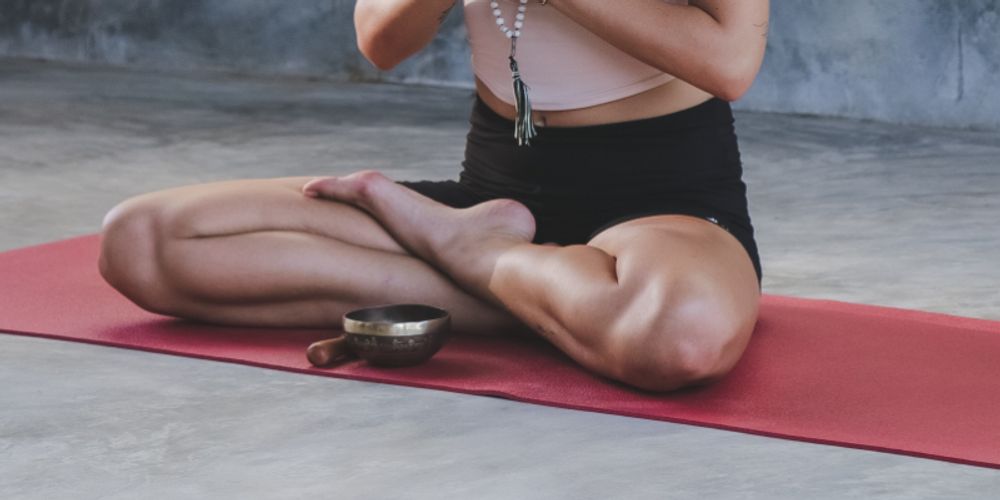Can You Meditate Without Crossing Your Legs?
-
 Dan Rivers
Dan Rivers
- 2 June 2022

There are various positions to meditation, but sometimes we question whether we are doing things right, and we second guess ourselves, instead of focusing on the meditation in question, causing the quality of our meditation and relaxation to suffer.
Meditation seen from a third-person point of view is almost always portrayed as someone sitting with their legs crossed (often known as Zen or ZaZen Meditation).
But there’s a reason for this: once you’re sitting, you’re less likely to fall asleep during the practice.
Sitting down straight can be painful in the psychological sense because we’re not used to it and the mind and body are often used to some type of movement or doing something.
Now, meditation should never be physically painful, if it is, it’s guaranteed to fail as what makes meditation what it should be is bringing our awareness in the present while enjoying a deep stage of relaxation.
You don’t necessarily have to sit down with your legs crossed to meditate, though, especially if it’s not comfortable for you. Many meditators never cross their legs and are still able to achieve the same benefits of meditation by simply using a normal chair and pillow.
It may feel less natural, but meditation today doesn’t ground itself on something esoteric, but instead, it’s available for everyone regardless of their belief system.
The more we make meditation accessible for everyone, the more popular it becomes, so I’ll dispel the myths that keep many from meditating in the first place.
But there are some reasons why you want to sit down while meditating, without necessarily crossing your legs for that.
Sitting Meditation Is Easier
From personal experience, I find that sitting during meditation, be it on a bench, mat, or chair makes it easier to focus on the present.
Once you’re able to focus on the present, you’re 80% there, because there’s the challenge of not being bothered or reactive to the thoughts that may arise that are designed to throw you off.
Meditation is a way to conquer yourself, and by putting yourself in a somewhat comfortable position, you’re taking the first step.
Sitting still for the mind without doing anything can make the mind fire neurons in all directions. But just like someone that lifts weights needs a break, so does the mind from all the inner chatter.
By sitting instead of laying, the mind is less likely to associate meditation with sleeping, and while being relaxed is great, it would defeat the purpose of meditation if we fall asleep to it unless one is doing it before bedtime.
But I find that the most efficient meditations tend to be done in the morning. However, on the flip side, falling asleep with meditation is optimal for those who meditate intending to have more lucid dreams.
Creating a routine and sitting down conditions the mind over time to adapt to something new, and what once was uncomfortable in the psychological sense, becomes blissful.
If you’re one of those that find comfort in keeping your legs crossed while meditating, however, you should, by all means, continue doing that, but if you’re one of those who don’t want to, you don’t have to. Simply sitting with your eyes closed in a comfortable position will do just fine.
Fewer Interruptions
One advantage I find sitting over laying down while meditating is that it’s easier to get my position right while sitting. When laying down, and going for a long, deep meditation, you may feel the need to move, much like you try to find a comfortable sleeping position.
However, the less interrupted you are, the easier it is to experience deep states of meditation and enter a flow state. If you, for instance, need to go to the bathroom at some point, make sure you do it before the meditation starts.
Make sure you’re not gonna be hungry or thirsty, obviously, I don’t recommend meditating after eating, but sometimes all you are is thirsty while thinking you are hungry, for many that are getting started and are using coffee as their daily routine, I recommend after that cup of coffee or tea as the sweet spot to start meditating.
Your day hasn’t started yet, you can sit down in a comfortable position and before any of your day-to-day problems disrupt your peace, you already start at a winning position, conquering those problems by meditating before anything.
Personally, I’m less likely to be interrupted by worry or stress if I begin my meditation or yoga practice in the morning, and it’s off my list as soon as possible.
Once meditation becomes a habit, you’ll find a subconscious voice craving it throughout the day if you postpone it, at least, that has been my experience.
That’s why I recommend both sitting in a comfortable position and doing meditation in the morning to make it less likely for the practice to be interrupted.
Now, I should mention that it’s okay to move during meditation if you have to, but try limiting movement as much as possible, but don’t second guess yourself if you happen to move to change to a more comfortable position. Simply, bring back your attention to what’s important – your breath.
Using a Bench vs. Having Your Legs Crossed
Good posture is vital for a meditation practice that’s of high quality. Therefore, I recommend using a bench over having your legs crossed, unless you’re used to having your legs crossed.
However, with a bench, you ensure you are in a good posture and less likely to be bothered by pain later down the line. Sometimes, such pain can manifest itself later on.
So if you’re sitting with your legs crossed, I recommend pushing your back against something, such as a wall or a tree, if you have the luxury to meditate on nature.
Trial and Error
You are unlikely to get your first meditation right, it’s a slow transition for the mind and body, but just like you should find the right meditation for you.
You must find the most comfortable position. If you manage to keep yourself still and for instance, lay down for hours and still enter a deep meditative state while retaining your awareness, you’re doing it right.
It’s just that this would usually be the exception, not the rule. Many turn to guided meditations for the worry of getting it wrong.
Now by getting it wrong, I don’t mean that you can’t meditate properly when you first start, I mean that you may feel like nothing is happening because your mind is distracted, and thus, you start doubting yourself, making the meditation less of an experience.
However, a good meditation usually starts with a good position, one you find is right for you. The more confident you become in your ability, which often comes as a result of trial and error, the more likely you are to see the rewards of meditation because there’s the absence of doubt.
In general, you should allow yourself to fail and get to a state where you’re able to keep your focus on your breath, almost by any means necessary, without compromising your well-being in the process.
This, by definition, would mean you’re meditating as you’re supposed to, regardless of if you are sitting with your legs crossed, laying down, or even standing up.


